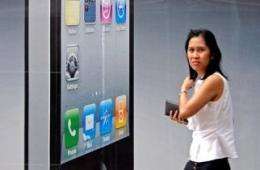Video making second mobile revolution

Smartphones and tablets are driving a mobile revolution, allowing video to take the lead in a business once dominated by voice calls, industry players and experts say.
Video already does or will soon account for the majority of mobile data traffic, according to companies that monitor traffic, and with the proliferation of tablet computers that is likely to increase.
"If you want to put 2011 into a nutshell you can say that for the mobile phone companies their business is changing from an ears business -- people speaking and hearing -- into an eyes business with people looking at little screens," said Stefan Zehle, CEO of Coleago Consulting.
Cisco chief John Chambers told the mobile industry's annual trade fair in Barcelona this week that the visual medium would soon become ubiquitous in mobile communication.
"It won't be fifty to sixty percent of traffic on networks in five years out that will be visual. It will be eighty to ninety percent. Everything you do will have visual capability."
Currently most of the visual traffic is video streaming, with video-sharing site YouTube the single top application accounting for 17 percent of total mobile data traffic, according to network firm Allot Communications.
However 2011 could be the year that video telephony finally takes off, nearly a half century after it was first invented.
Skype, which pioneered voice calls over the Internet, brought video calls to PCs in 2006 and says 42 percent of its calls are now video.
And now video calling is now moving to mobile handsets.
Skype launched last month video calling for the iPhone, and Apple has its own application, which is so far limited only to WiFi connections.
Another firm, ooVoo, now supports iPhones and smartphones running the Google-backed Android operating system for its free high-definition-capable video calling service.
ooVoo has gone from nine million users in January 2010 to 21 million last month.
"I really see 2010 as having been the tipping point for video calling," the company's chief executive, Philippe Schwartz, told AFP.
Stuck only to PCs, video calling would remain a niche service but "mobile is the enabler to make it mass market," he said.
US-based Syniverse Technologies announced this week at the Mobile World Congress a deal to provide a video calling service for Korea Telecom, the country's top fixed-line and second-largest mobile operator.
The service is highly interoperable as it does not require receiving handsets to have pre-installed software.
Another company, Aylus, announced a similar video calling service for operators which allows users to start conversations as audio calls and then freely switch over to video.
Both ooVoo and Aylus video calls can be made over existing 3G networks, and the video quality in demonstrations matched or exceeded PC video calls on fixed Internet conditions.
Not everyone is convinced video telephony will take off, however.
"I think the value for the end user to actually watch each other while talking is limited," said Magnus Rehle, managing director of Greenwich Consulting.
The consulting firm Deloitte said in a recent report it "believes that in 2011 video calling wil be cheaper, better and more widely available than ever; yet a boom in demand is unlikely."

It said for most calls audio is sufficient for users, and that many remain uncomfortable with video calling as it makes them self-conscious.
However a Skype representative said people don't want to be bound to their PCs and that mobile video calls "give users the opportunity to share personal moments wherever they are and whenever they want."
Smartphone handset makers, as well as tablet manufacturers, would not be equipping them all with front-facing cameras if they thought video calling would remain a niche service, he said.
Skype's success with PC-based video calling showed "that if there is an easy and intuitive application to use to see the other party then there is a big number of people" willing to use it, said Aylus chief executive Mark Edwards.
Syniverse's Tony Holcombe said consumers have been ready for mobile video calling for some time, "but the key to unlocking widespread uptake is full-scale interoperability" so all camera-equipped phones can be called.
With many smartphones now equipped with high definition cameras, they are likely to become increasingly used as camcorders.
A company called muvee expects to start shipping this year on Android phones the first application for users to edit their videos directly on their smartphones.
"Whenever you film you always get a bunch of rubbish that you want to trim and cut out," said muvee founder and chief Terence Swee. "You don't want to go through the hassle of transferring video to a computer to edit, you want to do it on your phone directly and with muvee you can."
(c) 2011 AFP




















